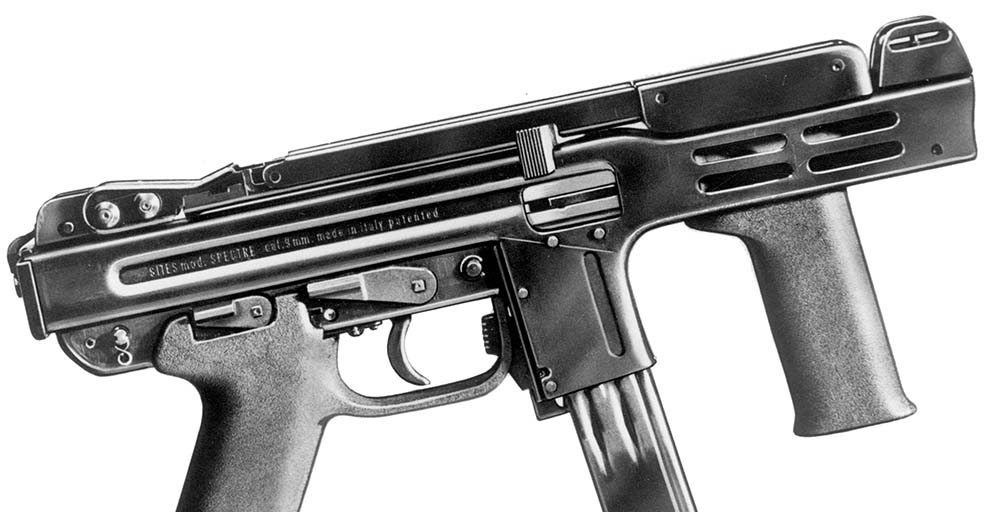Right view of the Spectre SMG with a compact 10-round magazine.
By J.M. Ramos
The Italian firm of Sites S.P.A. was founded in 1982 in Torino under the direction of Dott. Ing. Franco Manassero. The company specializes in the design and production of light weapons for modern warfare, particularly for anti-terrorism, counter-guerrilla and unconventional warfare. The design of the company’s first entry weapon, the Spectre, is the result of an analysis carried out by Sites research and development team based on the experience of 12 years of terrorism in Italy (1970-1982), as well as other terrorist’s activities and guerrilla warfare waged in various parts of the world.
The following are brief excerpts from the company’s analysis which led to the final design specification of the Spectre, a fourth generation submachinegun that truly posseses innovations that can be called totally new and radical since the introduction of the first submachinegun, the Italian Villar Perosa of 1915.
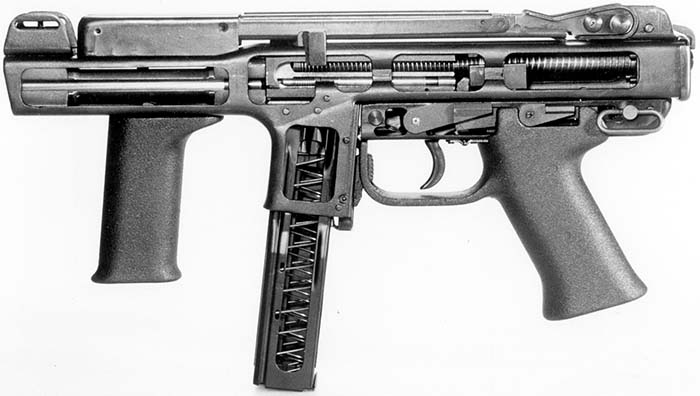
The question raised more often in combat or defence at close-range cannot be answered merely by technological research and development of weaponry and ammunition. The only adequate solution to a problem on which men’s lives or even the destiny of a nation is at stake, lies primarily in a careful analysis of the relationship between the weapon and his user as well as the result of their interaction. This analysis should not begin with the weapon, or ammunition, but the user himself. It is very important to understand the implications of close-range combat (40-10 meters). We must consider the psycho-physical reaction capability of a man under attack, the surprise factor, the effectiveness of training, the panic factor, the effect of panic on motion co-ordination, reaction time under extreme stress, reflex reactions and psychological conditioning. These findings can lead to the identification of the characteristics from which we can develop and create the mechanical aids (weapon and ammunition) as efficient as possible to overcome an aggressor or save lives.
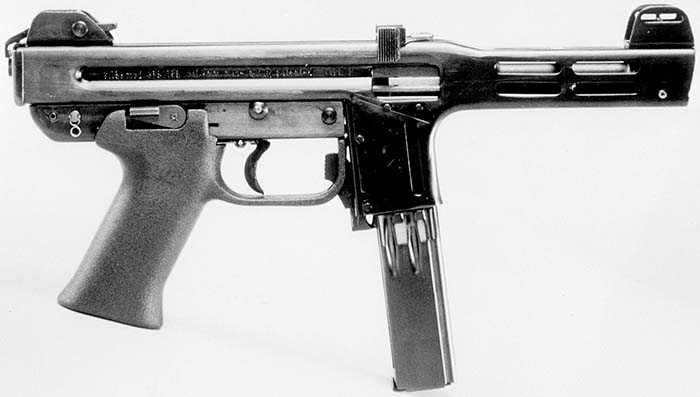
The first pre-production model of the 9mm Spectre submachinegun was introduced at the 1983 AUSA convention in Washington. The actual production of the weapon did not start until 1985. It was designated the Spectre M2.
FEATURES OF THE
SPECTRE MODEL-2
SUBMACHINEGUN:
The Spectre submachinegun represents the most radical close-quarter fourth generation submachinegun today. The weapon brings together a series of unique technical innovations, making it a revolutionary “new submachinegun” – more effective and safer than any weapon in its class. Spectre is the first automatic weapon in the world firing 900 rpm with three-action blow-back firing system.
Consequently, the weapon fires from a close-bolt principle assuring less mechanical distraction during firing as opposed to an “open-bolt” system incorporating heavy breech block mechanism. In addition, the three-action movement provides the weapon an exceptionally smooth firing cycle. The excellent stability results in an absence of climb with only minimal vibration during full automatic fire. The initial result from these advantages is extra-ordinary accuracy and the possibility of being able to fire the weapon accurately with one hand in the event of an emergency.
The Spectre offers maximum safety and instant readiness by eliminating unnecessary manually operated mechanism that would normally prevent accidental discharges in all type of combat scenarios. Similar classes of weapons may likely fail if dropped, jarred, hit etc. The incorporation of a unique double action trigger mechanism and a decocking lever, makes it possible to lower the hammer on a loaded round; allowing the weapon to be carried loaded with virtually no chance for an accidental discharge. The Spectre is truly an error-proof submachinegun. It fires only if and when the operator intends to shoot. The double action trigger mechanism assures instant readiness without having to manipulate separate safety mechanisms other than pulling the trigger. To complement its radically new trigger lockwork, the Spectre was designed with ambidextrous controls to accommodate both left and right handed users.
The Spectre features a patented four-file magazine using a single follower that is likely inspired by the 1931 Finnish Soumi submachinegun design. The Soumi system however has two separate rows of double column arrangement and individual followers separated by a center wall in the middle of the magazine tube. The Spectre magazine is only slightly thicker than normal double column type, but the same in length of 21 cm containing 50 rounds instead of 30. The advantage of maximum capacity in a weapon that fires 10-15 shot per second is self-explanatory.
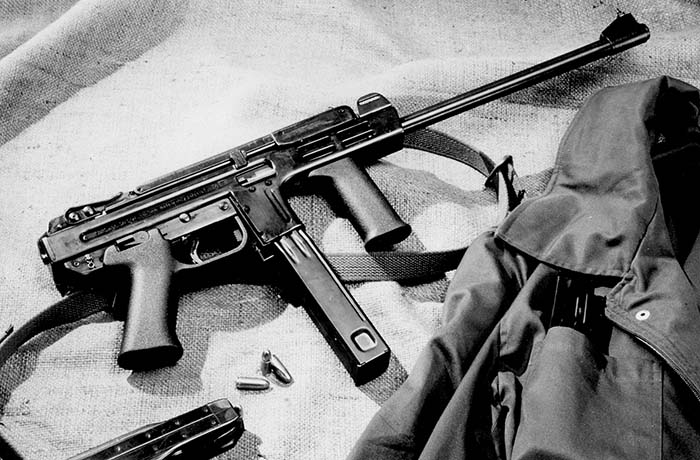
The handiness of a submachinegun is one of its important features. For this reason, the Spectre’s thickness has been kept within 35 mm even with the metal stock folded. This makes the weapon one of the slimmest submachineguns in the world allowing total comfort and without hindrance of movement when carried or deployed into action.
An ideal submachinegun must always function in rain, dust, sand, in cold climates, in jungle or other severe climatic conditions. Simplicity is the main characteristics of the Spectre. The close-bolt firing system prevents the entry of dirt or any foreign matter into the action which in turn assists in reliable operation of the weapon when subjected to various climatic conditions.
Almost all fully automatic weapons suffer from overheating of the chamber during prolonged bursts of fire. To overcome this problem, the Spectre incorporated a unique forced ventilation principle. The system operates by the movement of the bolt and keeps the chamber and barrel temperature down. The result is extraordinary, even after prolonged full auto fire the barrel can still be touched. This design advantage also minimizes or eliminates the possibility of dangerous cook-offs normally associated with closed bold arrangements.
The Spectre utilized a barrel featuring sinusoidal rifling. This type of rifling has no sharp corners, this prevents the incision of the bullet which passes with minimum of friction. With this rifling system, it is possible to use for the barrel lead steel that is self-lubricating and guarantees a smoother passage of the bullet in the bore. This also protects the barrel from wear from a weapon that is primarily designed to deliver high rate of fire in rapid successions.
As early as 1988, Sites begun to further refine the design characteristics of their original production Model 2 that can be characterized as functional and structural improvements. While the new Model 4 retained most of the basic features of the Model 2, the following changes was undertaken in order to further enhance the versatility of the original Spectre submachinegun design.
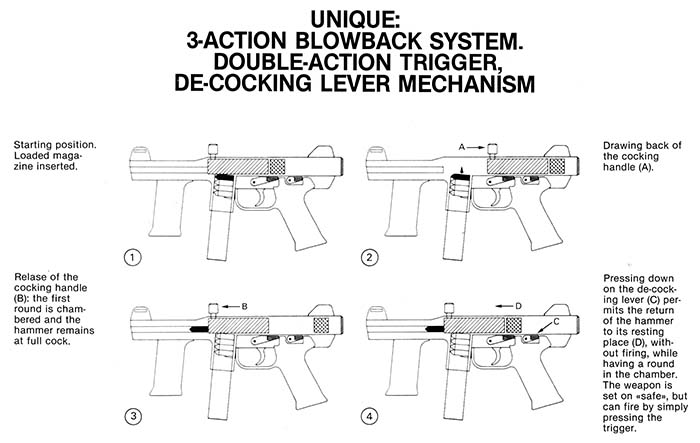
1. The original metal cocking handle with center spindle “U” notch “UZI type”, has been replaced by a flat sledge type handle using high-impact polymer material. This eliminates the possibility of the handle’s notch as a rear sight during fast aiming. The new design also strengthened the metal folding stock that no longer required the long slot to allow the movement of the cocking handle during operation while the stock is folded on the top of the receiver.
2. The lever shaped fire selector mechanism was replaced by a quarter-circle pattern in order to allow faster fire selection setting by the shooter’s thumb. The original had two separate levers that required separate activations.
3. The assembly and disassembly procedure has been changed with the newly re-designed interlocking components. The weapon now can be field stripped in less than 8 seconds without the use of any tools. Re-assembling is as easily accomplished. The weapon does not require any lubrication and rarely needs cleaning.
4. Stock configuration has been improved. The angle is lowered to allow a more comfortable aiming. Additional stiffening ribs have been added to maximize its strength.
5. The shape of the bolt and hammer has been re-designed. The new shape is patterned exactly like the internal form of the upper frame so that the air-pump effect is considerably increased. This allows for better cooling of the barrel and mechanical cleaning of foreign matters that may build up inside the action.
6. The front sight has been modified in order to allow elevation and windage adjustments.
7. The new design of the M4 allows for quick barrel removal that permits easy substitution of a longer threaded barrel for silencer requirements for use by clandestine operatives.
8. Sintered parts like the M2 selector and de-cocking levers are replaced by metallic inserts bedded in high impact polymer which are much stronger and more comfortable to activate specially in extremely cold temperatures.
9. The shape of the magazine catch has been modified to allow faster and more accessible operation during quick magazine changing.

In addition to the Spectre Model 2 and Model 4 submachineguns, Sites also produced semi-auto variants for the civilian market. These include the Spectre pistol and Spectre Carbine both chambered for the 9mm parabellum. The Spectre pistol utilizes all the submachinegun features and uses the same magazines but fires semi-auto only and without a stock. Only the decocking lever for the double action trigger lockwork is mounted in the frame.
The Spectre Police Compact Carbine (PCC System) has all the innovative features of the submachinegun version except its semi-auto functioning. It features a 420 mm long barrel and the usual metal folding stock of the submachinegun model. Like the pistol model, only the decocking lever is mounted in the frame. The semi-auto model fires approximately 200 rpm (approx. 3-shot per second).
In conclusion, Sites is one of the very few arms producers in the world who manufacture their wares starting from the user’s need; interviewing law enforcement personnel and undercover agents who survive terrorists attacks, trying to understand the physiological results of panics from which the encounter is drawn (pressure, adrenaline, stress, flow, etc.). From these experiences the Spectre weapon system was incepted. The technical solutions are examined and incorporated not merely improving the accuracy of such weapon at 300 meters, but to give the user a safe, rugged and reliable instrument which he can do his task more efficiently and effectively. The Spectre submachinegun is patented world-wide and currently in use by numerous agencies around the world. Limited numbers of Spectre semi-auto carbine and pistol variants were briefly imported into the U.S. market by F.I.E. in the late 1980’s during the heyday of paramilitary weapons market. These guns are now one of the most sought after by military subgun collectors which will no doubt only increase in value as such class of weapon is hard to come by. The author tested both the submachinegun (police sample) and semi-auto civilian models in late 1990’s and found all models to be exceptional in both accuracy and reliability.
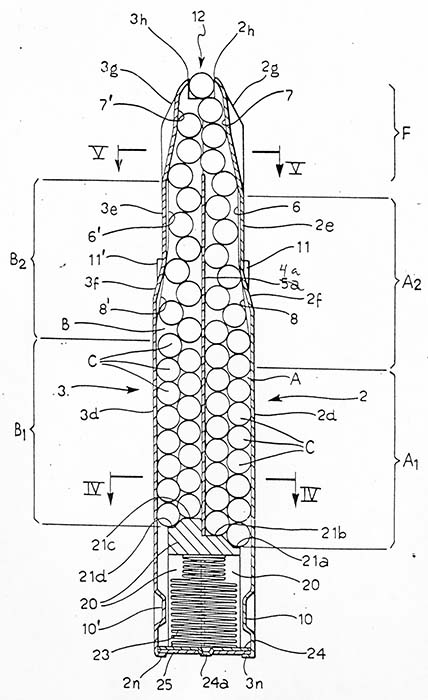
While the double action pull is a bit heavy at 10 lbs., its intended purpose is safety. It’s like carrying a double action pistol like the Walther PPK or P-38. After introducing a round in the chamber, the hammer will remain in cocked position. Depressing the slice mounted lever will drop the hammer but will not fire the weapon due to its built-in firing pin block. To fire the gun, simply pull the trigger via heavy double action pull. The recoil will automatically recock the hammer for the next shot that will result in a lighter 4-5 pound pull. If you wish to stop shooting and like to return the hammer in “safe” forward position with a loaded chamber, simply depress the slide mounted lever to once again drop the hammer for double action trigger pull. The Spectre trigger lockwork principle works in the same manner except it uses a small metal block that travels behind the bolt rather than a pivoting hammer. The decocking lever rest is above the grip in the Spectre, while its fire selector lever is positioned just forward of it. Its single action pull provides a smooth and crispy 4 pound pull and is virtually consistent each shot. Quality of workmanship is excellent; something to be expected from a well organized research and development division of a very resourceful company. The Spectre is indeed one of the most technologically advanced SMG in the world, loaded with features that very few if any will ever equal or exceed.
| This article first appeared in Small Arms Review V4N8 (May 2001) |



